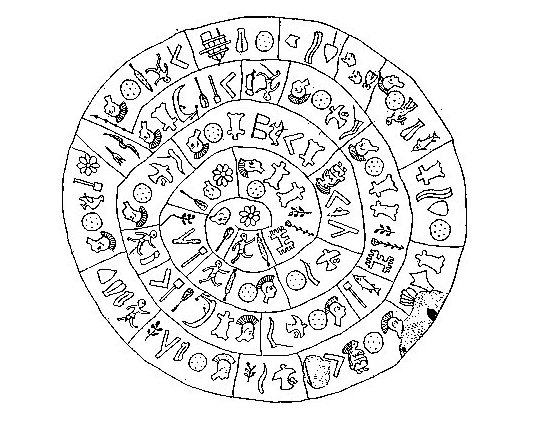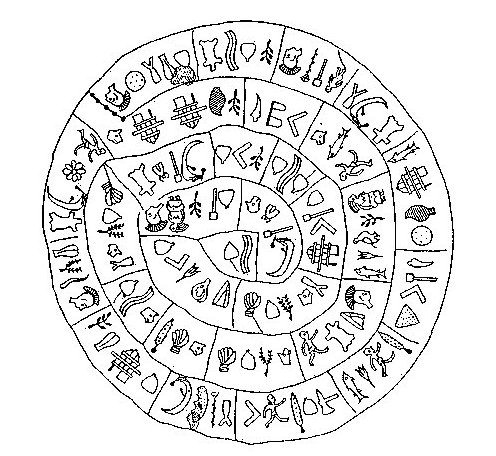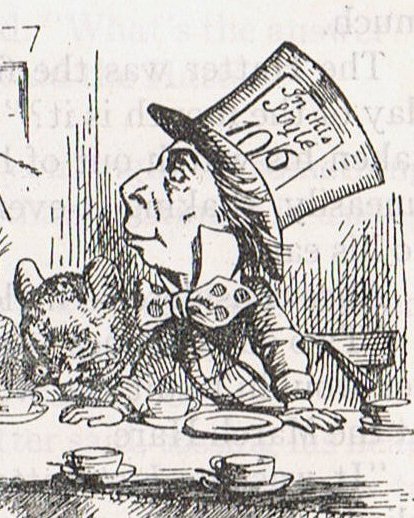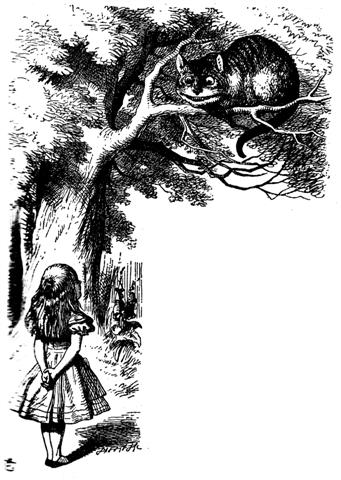11-2. On the Phaistos disc we have tried
to count ahead from the end of its top side by following the
glyph text down onto the bottom side in the natural way, i.e. after
having gone down from the top to the perimeter on the top side
the trail should then go up again from the perimeter to the the top
on the bottom side.


As perceived from the center
(top) of
the bottom side this seems to imply there remained 61 days
from April 10 (100) up to June 10 (161 → 354 / 2 - 16):

... Midsummer is the
flowering season of the
oak, which is the tree
of endurance and
triumph, and like the
ash is said to 'court
the lightning flash'.
Its roots are believed
to extend as deep
underground as its
branches rise in the air
- Virgil mentions this -
which makes it
emblematic of a god
whose law runs both in
Heaven and in the
Underworld ... The
month, which takes its
name from Juppiter the
oak-god, begins on June
10th and ends of July
7th. Midway comes St.
John's Day, June 24th,
the day on which the
oak-king was
sacrificially burned
alive. The Celtic year
was divided into two
halves with the second
half beginning in July,
apparently after a
seven-day wake, or
funeral feast, in the
oak-king's honour
...
|
June
10 (*502) |
*100 |
Sept 18 (261) |
*60 |
Nov 17 (321) |
|
NIHAL
(*81) |
π Virginis |
π Scorpii |
Such a perspective could somehow
have been implanted in the mind of Metoro:
... For some reasons Metoro
read the lines on side b backwards, starting with Eb1-36,
-35, 34 ... and ending this line with Eb1-3, -2, -1. Though
Eb1-37 -- -42 were left until after having read the
mentioned glyphs and Eb2-27, -26, -25 ... -3, -2, -1 (in
that order). Then he finished line Eb1 in the (presumably)
right order: Eb1-37 -- -42. The close correlations between
what Metoro was saying and the glyphs makes it absolutely
clear that this is what happened. I have presumed that
Metoro was wrong in reading backwards like that and
therefore I present glyphs and Metoro's readings adjusted
after the order of the glyphs, not according to the order of
his reading ...
|
Eb1-36 |
34 |
Eb1-1 |
Eb2-27 |
25 |
Eb2-1 |
|
36 + 27 = 63 |
|
Nov 5 (*229) |
6 |
7 |
8
|
9 → 108 |
10 (314) |
11
(*235) |
|
 |
 |
 |
 |
 |
 |
 |
|
Eb1-30 |
Eb1-31 |
Eb1-32 |
326 + 33 |
Eb1-34 (360) |
Eb1-35 |
Eb1-36 |
|
ka tu i te toga te manu -
hua te vaero |
tagata puoko kore |
oho hukiga - te rima |
vanaga hia |
hare pure |
i te rima |
Kua vare |
|
37 |
2 |
9 |
28 |
12 |
9 |
 |
 |
 |
|
107 |
108 |
109 |
110 |
123 |
|
*312 |
*313 |
*314 |
π - 3.14 |
*328 |
|
Jan 27
(392) |
16 |
|
July 29 (210) |
|
Ea8-4 (260) |
no glyph |
ki te vai |
(te hupee) |
|
NASHIRA |
Vare.
Spittle, drivel, any viscous liquid;
viscous; vare māmari, egg white;
pipi-vare, slug. Vanaga. Varevare,
steep, rugged. Tu.: vare, to lose
consciousness. Barthel 2. 1. Hakavare,
to crisp, to plaster; hakavarevare,
to level. 2. Driveler. P Mgv.: vare,
clumsy, inept. Turivare, abscess at
the knee. Varegao, to speak
indistinctly, to offend, to pretend.
Varevare: 1. Steep, rugged. 2. Smooth,
plain, without rocks; horo varevare,
without branches; tino varevare,
slender; kona varevare, open place,
court, market place. PS Sa.: valevale,
fat. To.: valevale, young, tender,
applied to babies. In Nuclear Polynesia it
is difficult to dissociate this vale
from the vale conveying the sense of
ignorance. In Samoa this varevare
appears only as applied, lē valevale,
to a hog that is not fat. It is probable
that varevare
2 preserves the Proto-Samoan primitive and
that the sense-invert, in the preceding
item, is directed away from the germ-sense.
Churchill. ... And
then
she looked in her hand, she inspected it
right away, but the bone's saliva wasn't in
her hand. It is just a sign I have given
you, my saliva, my spittle. This, my head,
has nothing on it - just bone, nothing of
meat. It's just the same with the head of a
great lord: it's just the flesh that makes
his face look good. And when he dies, people
get frightened by his bones. After that, his
son is like his saliva, his spittle, in his
being, whether it be the son of a lord or
the son of a craftsman, an orator ...

Vanaga.
To speak, to talk, to pronounce;
conversation, talk, word, language; he
vānaga i te vānaga rapanui, to speak
Rapanui; vānaga reoreo, lies, lying
words, falsehoods. Vanavanaga, to
talk at length; useless talk. Vanaga. To
speak, to say, to chat, to discourse, to
address, to recount, to reply, to divulge,
to spread a rumor; argument, conversation,
formula, harangue, idiom, locution, verb,
word, recital, response, speech; vanaga
roroa, chatterbox, babbler; rava
vanaga, candid, babbler; tae vanaga,
discreet; tai vanaga, ripple;
vanagarua (vanaga - rua
1), echo. P Pau.: vanaga, to warn by
advice. Mgv.: vanaga, orator, noise,
hubbub, tumult. Mq.: vanaa, orator,
discourse, counsel, advice. Churchill.
|
|
ω
Oct. (229.3),
ι
Librae (229.6),
κ
Lupi (229.7),
ζ
Lupi (229.8) |
Al Zubānā-14b (Claws)
χ
Bootis (230.3),
PRINCEPS =
δ
Bootis
(230.6),
ZUBEN ELSCHEMALI (Northern Claw) =
β
Librae
(230.8) |
μ
Lupi,
γ
Tr. Austr.
(231.3), ο Librae (231.8) |
ο
Cor. Borealis (232.0),
δ
Lupi (232.1),
φ¹,
ν²
Lupi (232.2),
ν¹
Lupi (232.3),
ε
Lupi (232.4),
φ²
Lupi (232.5),
PHERKAD (The Dim One of the Two Calves) =
γ
Ursae Min.
(232.6),
ε
Librae (232.7),
η
Cor. Borealis (232.8),
υ
Lupi (232.9)
*191.0 = *232.4 - 41.4 |
ALKALUROPS (The Herdsman's Lance) =
μ
Bootis
(233.1),
ED ASICH (Male Hyena) =
ι
Draconis
(233.2) |
NUSAKAN (Pauper's Bowl) = β Cor. Bor.
(234.0), κ¹ Apodis (234.3), ν Bootis (234.7), ζ
Librae (234.9) |
θ Cor. Borealis (235.3), γ Lupi (235.6),
GEMMA = α Cor. Bor.,
ZUBEN ELAKRAB = γ Librae, QIN = δ Serpentis, ε
Tr. Austr.
(235.7), μ Cor. Borealis (235.8), υ Librae
(235.9)
SIRRAH (α Andromedae)
|
|
ι
Persei (46.1),
MISAM (Next to the Pleiades) =
κ
Persei
(46.2),
GORGONEA QUARTA =
ω
Persei
(46.7),
BOTEIN (Pair of Bellies) =
δ
Arietis
(46.9) |
ζ Arietis (47.7) |
ZIBAL (Young Ostriches) = ζ Eridani (48.0),
κ
Ceti (48.9) |
τ Arietis (49.7) |
ALGENIB PERSEI = α Persei (50.0),
ο Tauri (50.2), ξ Tauri (50.8)
GIENAH (γ Corvi) |
σ Persei (51.6) |
No star listed (52) |
|
... In other words, the ancient Druidic religion
based on the oak-cult will be swept away by
Christianity and the door - the god Llyr - will
languish forgotten in the Castle of Arianrhod,
the Corona Borealis. This helps us to
understand the relationship at Rome of Janus and
the White Goddess Cardea who is ... the Goddess
of Hinges who came to Rome from Alba Longa. She
was the hinge on which the year swung - the
ancient Latin, not the Etruscan year - and her
importance as such is recorded in the Latin
adjective cardinalis - as we say in
English 'of cardinal importance - which was also
applied to the four main winds; for winds were
considered as under the sole direction of the
Great Goddess until Classical times ... |
|
Oct 7 (280 =
40 weeks) |
8 |
9 (282 → 2 *
141) |
 |
 |
 |
|
Eb1-1 |
Eb1-2 |
Eb1-3 |
|
tagata mau kupega |
te henua |
te maitaki |
|
Kupega.
He-tį i te kupega, to weave (a net). Hopu
kupega, those who help the motuha o te
hopu kupega in handling the fishing nets.
Huki kupega, pole attached to the poop from
which the fishing-net is suspended.
Mata kupega, mesh. Te matu'a o te kupega,
part of a net from which the weaving started.
Te puapua kupega, the upper part of a
fishing net. Tau kupega, rope from which
is hung the oval net used in ature
fishing. Tuku kupega, a fishing
technique: two men drag along the top of a
fishing net doubled up, spread out on the bottom
of a small cove, trapping the fish into the net.
Vanaga.
Maitaki. Clean, neat,
pure, pretty, nice, beautiful, handsome;
tagata rima maitaki, clean-handed
man, correct man. Vanaga. 1. Good. Henua
maitaki = the good earth. 2. Shine.
Marama maitaki = the shining moon. Barthel.
Ce qui est bon. Jaussen according to Barthel.
Meitaki, good, agreeable, efficacious,
excellent, elegant, pious, valid, brilliant,
security, to please, to approve (maitaki);
ariga meitaki, handsome, of pleasant
mien; mea meitaki ka rava, to deserve;
meitaki ke, marvelous, better.
Hakameitaki, to make good, to amend, to do
good, to bless, to establish. Meitakihaga,
goodness. PS Pau.: maitaki, good. Mgv.:
meitetaki, beautiful, good. Mq.:
meitai, good, agreeable, fit, wise,
virtuous. Ta.: maitaiki, good, well.
Niuē: mitaki, good. Maitakia,
clean. Churchill. |
|
CLOSE TO THE
FULL MOON: |
|
σ Virginis (200.4)
*159.0 = *200.4 - *41.4 |
γ
Hydrae (201.0),
ι
Centauri (201.4)
*160.0 = *201.4 - *41.4 |
Al Simāk-12 (Lofty)
/
Chitra-14 (Bright One)
/
Horn-1 (Crocodile)
/
Sa-Sha-Shirū-19 (Virgin's
Girdle)
/
ANA-ROTO-3 (Middle pillar)
MIZAR =
ζ
Ursae Majoris (202.4),
SPICA = α Virginis,
ALCOR (The Fox) = 80 Ursae
Majoris
(202.7)
SADALMELIK (α Aquarii) |
 |
|
INVISIBLY
CLOSE TO THE SUN: |
|
ν Phoenicis (17.4),
κ Tucanae (17.6)
*159.0 + *182.0 = 341.0 |
No star listed (18) |
ADHIL
(Garment's Train) = ξ Andromedae
(19.3),
θ
Ceti (19.7) |
|
April 7 (107
= 280 - 183) |
8 (108) |
9 (109) |
|
FEBR 2 (365 + 33 = 408) |
3 |
4 (45 = 109 - 64) |
Ending his strange withershins reading where the Sun reached day
109 and with nakshatra Full Moon ideally at Spica should now
seem quite
natural for us.
... Proclus informs us that the fox star
nibbles continuously at the thong of the yoke which holds
together heaven and earth; German folklore adds that when
the fox succeeds, the world will come to its end. This fox
star is no other than Alcor, the small star g near
zeta Ursae Majoris (in India Arundati, the common
wife of the Seven Rishis, alpha-eta Ursae ...

According to the Chinese Spica ruled the first of their lunar
stations, and number 109 was similar to the thread of
Ariadne which lead us
to a perceived correspondence between the Phaistos disc and the E text:
|
37 |
2 |
9 |
28 |
12 |
9 |
 |
 |
 |
|
107 |
108 |
109 |
110 |
123 |
|
*312 |
*313 |
*314 |
π -
3.14 |
*328 |
|
Jan 27
(392) |
16 |
|
July 29 (210) |
|
Ea8-4
(260) |
no glyph (9 * 29) |
ki te vai |
(te hupee) |
|
NASHIRA |
Moving across the border from one hemisphere to the other
was definitely a
hazardous quest.
... Dante kept to the tradition
of the whirlpool as a significant end for great figures,
even if here it comes ordained by Providence. Ulysses has
sailed in his 'mad venture' beyond the limits of the world,
and once he has crossed the ocean he sees a mountain looming
far away, 'hazy with the distance, and so high I had never
seen any.' It is the Mount of Purgatory, forbidden to
mortals. 'We rejoiced,
and soon it turned to tears, for from the new land a whirl
was born, which smote our ship from the side. Three times it
caused it to revolve with all the waters, on the forth to
lift is stern on high, and the prow to go down, as Someone
willed, until the sea had closed over us.' The 'many
thoughted' Ulysses is on his way to immortality, even if it
has to be Hell. The engulfing whirlpool belongs to the
stock-in-trade of ancient fable. It appears in the Odyssey
as Charybdis in the straits of Messina - and again, in other
cultures, in the Indian Ocean and in the Pacific. It is
found there too, curiously enough, with the overhanging fig
tree to whose boughs the hero can cling as the ship goes
down, whether it be Satyavrata in India, or Kae
in Tonga ...

|








